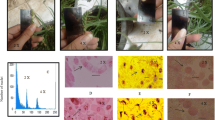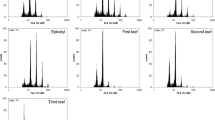Abstract
Ploidy of watermelon [Citrullus lanatus (Thunb.) Matsum. and Nakai shoots and plantlets was estimated by painting the lower epidermis of intact in vitro-derived leaves with fluorescein diacetate (FDA) and observing fluorescence of guard cell chloroplasts with a microscope and UV light. Leaves from in vitro shoot-tip cultures of known diploid cultivars and tetraploid breeding lines were used to establish the mean number of chloroplasts per guard cell pair. Leaves from diploid and tetraploid shoot cultures had 9.7 and 17.8 chloroplasts per guard cell pair, respectively. This method then was used to estimate the ploidy of shoots regenerated from cotyledon explants of the diploid cultivar Minilee. Approximately 11% of the 188 regenerated shoots were classified as tetraploid during in vitro culture. Putative tetraploids were transplanted to the field and self-pollinated. About 45% of tetraploids identified in vitro produced fruit and viable seed. Chloroplast counts of R1 progeny were used to confirm their ploidy. All of the putative diploids were confirmed diploid and all putative tetraploids proved to be non-chimeric true breeding tetraploids.
Similar content being viewed by others
References
Andrus CF, Seshadri VS & Grimball PC (1971) Production of seedless watermelons. Agricultural Research Service, United States Department of Agriculture Technical Bulletin No. 1425
Compton ME & Gray DJ (1992) Micropropagation as a means of rapidly propagating triploid and tetraploid watermelon. Proc. Fla. State Hort. Soc. 105: 352-354
Compton ME & Gray DJ (1993) Shoot organogenesis and plant regeneration from cotyledons of diploid, triploid and tetraploid watermelon. J. Amer. Soc. Hort. Sci. 118: 151-157
Compton ME, Gray DJ & Elmstrom GW (1993) A simple method for micropropagating diploid and tetraploid watermelon using shoot-tip explants. Plant Cell Tiss. Org. Cult. 33: 211-217
Compton ME, Gray DJ & Elmstrom GW (1996) Identification of tetraploid regenerants from cotyledons of diploid watermelon cultured in vitro. Euphytica 87: 165-172
Gray DJ & Elmstrom GW (1991) Process for the accelerated production of triploid seeds for seedless watermelon cultivars. United States Patent No. 5,007,198
Kihara H (1951) Triploid watermelons. Proc. Amer. Soc. Hort. Sci. 58: 217-230
Marr CW & Gast KLB (1991) Reactions by consumers in a 'farmers' market to prices for seedless watermelon and ratings of eating quality. HortTechnol. 1: 105-106
McCuistion G & Elmstrom GW (1993) Identifying polyploids of various cucurbits. Proc. Fla. State Hort. Soc. 106: 155-157
Mohr HC (1986) Watermelon breeding. In: Bassett, M (ed). Breeding Vegetable Crops (pp 37-66). AVI Publ. Co., Westport, CT
Singsit C & Ozias-Akins P (1992) Rapid estimation of ploidy levels in in vitro-regenerated interspecific Arachis hybrids and fertile triploids. Euphytica 64: 183-188
Singsit C & Veilleux RE (1991) Chloroplast density in guard cells of leaves of anther-derived potato plants grown in vitro and in vivo. HortSci. 26: 592-594
Author information
Authors and Affiliations
Rights and permissions
About this article
Cite this article
Compton, M.E., Barnett, N. & Gray, D. Use of fluorescein diacetate (FDA) to determine ploidy of in vitro watermelon shoots. Plant Cell, Tissue and Organ Culture 58, 199–203 (1999). https://doi.org/10.1023/A:1006371516394
Issue Date:
DOI: https://doi.org/10.1023/A:1006371516394




